 Sámegillii
Sámegillii  På norsk
På norsk
Articles about Sami school history
Part 17 - printed in Ávvir 10.09.2010
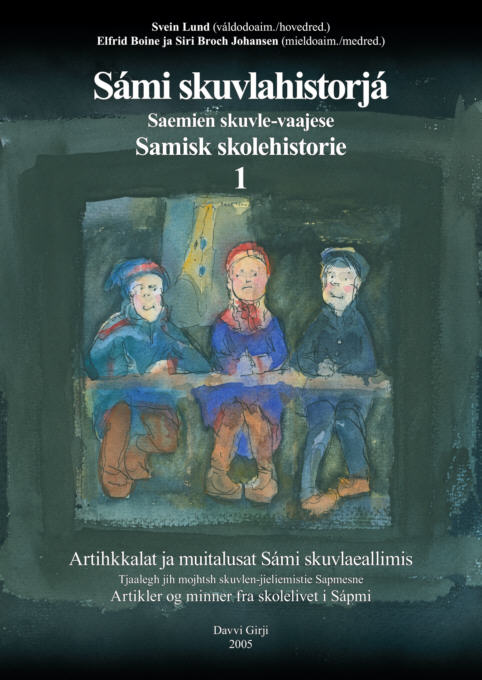 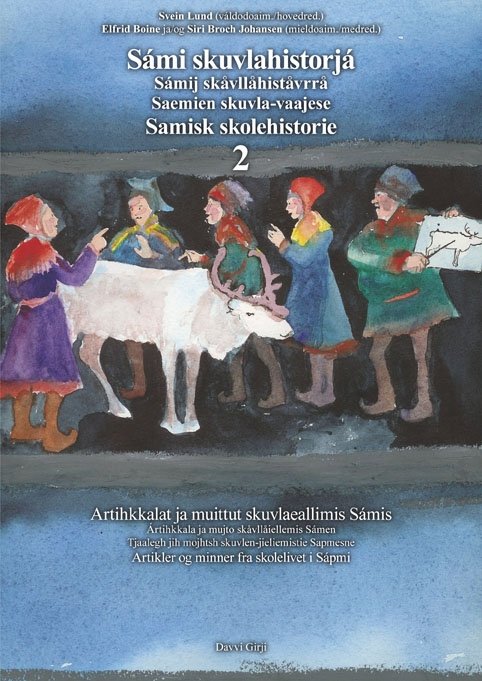 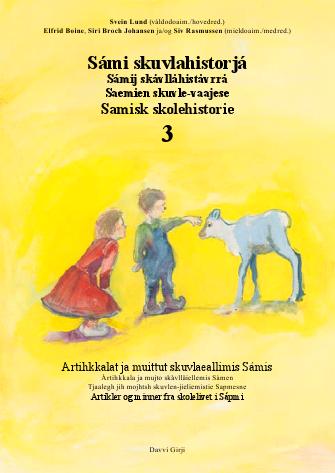 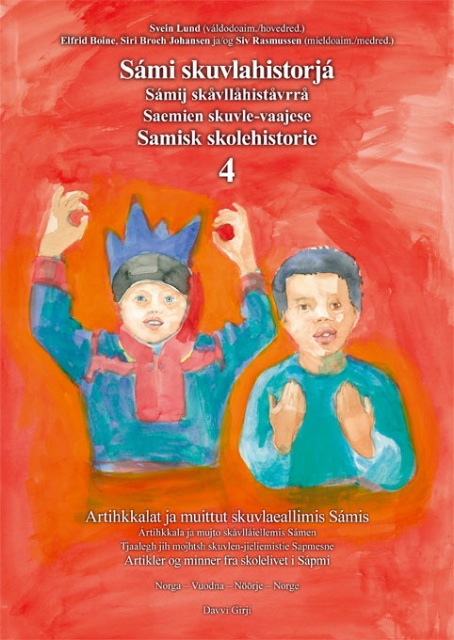 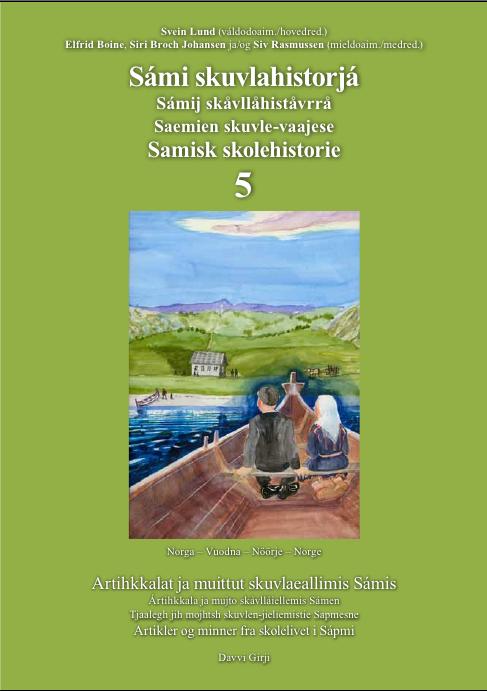
Do you know Sami school history?Sámi skuvlahistorjá / Samisk skolehistorie (Sami School History) is a series of books published by the publishing house Davvi Girji. In about 200 articles in 5 volumes there is told about the experiences of Sami children in Norwegian schools, and about the changes in the educational politics of the Norwegian authorities towards the Sami population. The books are published with parallell text in Sami and Norwegian language.In this web site some of the articles of the first book are also published in English. It would be too much to translate it all, so to make this history available to a greater public, we are translating a series of newspaper articles, which sorted by topics make a summary of stories in the books. So far there are 28 articles published in Sami language by the Sami newspapers Min Áigi and Ávvir. They are also published here in Norwegian and the English version will be published gradually as they are translated. These articles are edited by the main editor, Svein Lund. Besides him the editing board of the book series consist of Elfrid Boine, Siri Broch Johansen and Siv Rasmussen. |
In this article we will have a look at the argumentation from the Norwegianizing side, through selected examples from the 1700- and 1800's. (All quotes from SSH-4)
The first powerful advocate for Norwegianization was Peder Krog. He was bishop in Nidaros, which at the time comprised of the entire Trøndelag and Northern Norway. In his time the king and the missionary board in Copenhagen started a grand-scale evangelization and teaching in Sami, under the direction of Thomas von Westen. But the bishop was counteracting this work, declaring that he did not believe in "the joyous conversion of the Lapps (Sami) and the Finns through the recently implemented catechization".
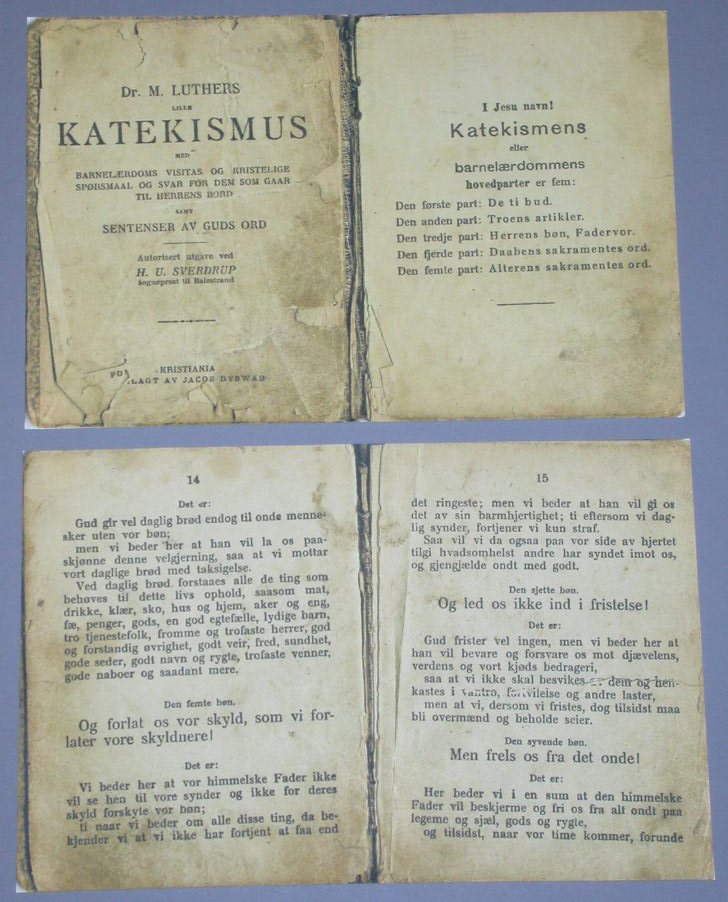 |
For many years the catechism was among the most important textbooks, and often Sami pupils had to read this in Norwegian. (Museum of Porsanger) |
The bishops had a positive view on Sami in the period 1743–73, but all the time influential people in the public administration held the oposite view. Among them were Gunder Hammer, county governor in Finmarkens county, which in 1758 sent the missionary board a proposal regarding the teaching and confirmation of Sami youths. He was of the opinion that this should be conducted in Norwegian, and that the priests should refuse to confirm those who had not learned their Christianity in Norwegian. Also more priests and missionaries claimed the same, among them dean Hans Frugård in Alta, who sent the missionary board a proposal that «the Lappish (Sami) language needs to be discarded as far as possible». To many of the missionaries this view was probably connected to the fact that they had not managed to learn Sami themselves, as in periods had been their instruction. County governor Christen Heiberg and dean Christopher Garmann proposed that Sami people who had not learned Norwegian should be denied to marry.
In 1774 the episcopal residence was taken over by the Dane Markus Frederik Bang, who was an irreconcilable opponent of the Sami language and declared that God does not hear prayers in Sami. He made sure that the Seminarium lapponicum was closed by a Royal decree in 1774, where it says: «... Seminarium lapponicum is dissolved, as the Norwegian language shall be introduced among the Lapps (Sami), and the young are instructed to learn their Christianity in Norwegian». Bang was so harsh in his decision that all teaching should be held in Norwegian (Danish) that he reprimanded priests and missionaries who continued to use Sami in their churches and enjoined the royal «Order that the Lappish youth are instructed to learn their Christianity in Norwegian, needs to be obeyed».
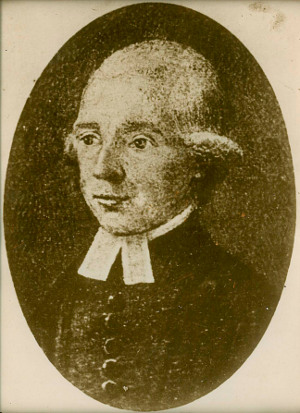 |
Bishop Johan Christian Schønheyder was one of the strongest opponents of the Sami language. (Photo borrowed from Nidaros diocese) |
Bishop Bang's successor, Johan Christian Schønheyder, was just as irreconcilable towards the Sami language. In a report he sent to the king 18. December 1790 he writes: «As the Royal Rescript of November 3rd 1774, whereby Seminarium Lapponicum was abolished, it is and should be passed, that it is lost and futile work to teach the Lapps Christianity and thereby associated worship practiced in their own language. As the language in itself is completely unutilised and unaccustomed to spiritual ideas, reduced to the perceptible and few things in which these uncivil people in their limited use of nature and the powers of humanity, make use of.» He put the blame of the poor Christian- and general knowledge among the Sami to «the despised language, which held the Worship and the religious teaching away from them» and he criticized the priests for «of forgivable vanity to have developed a love for the Lappish language».
Early in the 19th century the pendulum swung again, and with the priests F.W. Deinboll and N.V. Stockfleth as driving forces Sami as teaching language was strengthened throughout the first half of the 19th century.
But the advocates of Norwegianization had by no means given up, and Stockfleth had to bear many tough attacks on his work. One example is an anonymous contribution which was printed in Tromsø Tidende nr. 73-1840: «That it is now given attention to the Lappish language is solely because of that man, who has devoted himself to this nomadic people; but the politically correct in this government's procedure is doubted by many, just as nature itself is speaking against the use of maintaining a language, which is only spoken by people who nurture the greatest disgust to become resident taxpaying citizens.»
From the middle of the 19th century things changed again. One of the driving forces this time was the dean Julius Aars in Alta. As a member of the Storting he proposed to establish so-called transitional-districts, where the teaching was to be held in Norwegian also for Sami and Kvens. Meanwhile norwegianizers started the fight to change the teacher's education in Northern Norway, which up until then had been focusing to a great extent on the Sami and Kven languages and to recruit Sami and Kven teachers. In the end of the 1850's bailiff Martinus Drejer in Tromsø wrote to the manager of the Tromsø seminary Fredrik Hvoslef:
" ... in regard of the school teacher one therefore once again need to reconsider the question that was already disputed in the time of the missionaries, wether it truly is to school teachers being Norwegian by birth who have learned the Lappish (Sami) language, or school teachers being Lappish by birth who have acquired knowledge of the Norwegian language, one should entrust the teaching of the Lappish in those parishes, which are designated transitional-districts, and where the Lappish language already is strongly influenced by the Norwegian, and where the Lappish language due to the Lapps relation to the cohabiting Norwegian is close to it's destruction. That, of which the decision of this question is depending, is presumed the security, that one will acquire that the Norwegian language is not made into an object, which the Lapps are imposed to detest, or which they are prohibited to utilise. ...
Thus it should presumably be made an unconditional rule, that only teachers of Norwegian birth or only people, which are of Norwegian birth and not have acquired knowledge of the Lappish language, are appointed as school teachers among the Lapps in the transitional-districts."
On the basis of this Hvoslef writes to the Diocese Board of Directors. He makes a few reservations, but supports the principal line that there should be Norwegian teachers for the Sami pupils. Later Hvoslef himself was appointed bishop and thus member of the Diocese Board of Directors, which from 1862 to 1880 passed increasingly stricter language instructions in order to ensure the transition from Sami to Norwegian as the language of teaching.
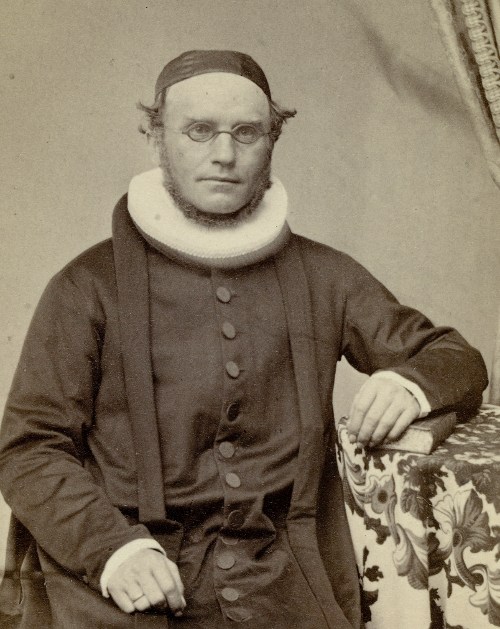 | Fredrik W. Hvoslef (Photo: Claus Knudsen / The National Archives) |
Recently it has been claimed that one did not have a choice at that time, but had to teach in Norwegian due to the lack of Sami speaking teachers and teaching materials in the Sami language. Provided that one seeks out the sources on the contrary it becomes evident that it was a clear policy to prevent Sami to get a teacher's education, to change Sami teachers with Norwegians and to prevent publications in the Sami language. And when in addition it was necessary to make instructions to ensure that Norwegian became the language of teaching four times, everything indicates that it would have been possible to choose a different policy, where Sami teachers could have taught Sami pupils with Sami books.
And in that case, the language situation of today might have been completely different.
Here you find all the articles in the series:
28.09.2007 Why Sami school history?
05.10.2007 Boundless ignorance
12.10.2007 Southerner-teachers encounter the Sami language
19.10.2007 The start of Sami beginner instruction
26.10.2007 The start of education in reindeer-herding
02.11.2007 From Sami to Norwegian vocational training
16.11.2007 Struggle for Sami gymnasium
28.11.2007 School experiences of Norwegian speaking Samis
14.12.2007 Resistence against Sami language and culture
25.01.2008 A strange world
23.05.2009 On Sami teachers
30.05.2009 Life in boarding school
06.06.2009 Sami pupils were bullied
13.06.2009 Sami content in the teaching
20.06.2009 Pupil as interpreter
04.07.2009 How the children quit speaking Sami
10.09.2010 God does not understand Sami
08.10.2010 The point of view of the Norwegianizers
13.10.2010 Men of the church defending the Sami language
02.12.2010 Sami teachers in old times
09.12.2010 Boarding school life in old times
18.12.2010 Sami pupils in special schools
14.01.2012 The parents' struggle for Sami education
21.01.2012 Reluctance and absence
28.01.2012 The school during the war
04.02.2012 Reconstruction and barrack schools
11.02.2012 Curriculums - for Norwegianization and for Sami school
18.02.2012 The great struggle of the curriculum
Sami school history 1
Sami school history 2
Sami school history 3
Sami school history 4
Sami school history 5
Sami school history - main page